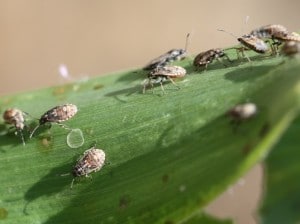Calls have diminished about false chinch bugs in cotton. However, calls about new infestations are still trickling in, so we are not necessarily out of the woods. There have been many fields treated with insecticide, and spot replanting was also needed in a number of fields where the problem was not quickly identified. You can have few bugs one day and an epidemic 3-4 days later, and infestations often start in small patches that can be easily missed. So far, reports of problems have been isolated to Hardeman, Fayette, Madison, Haywood, Crockett, Gibson and a few fields in Carroll County.
 Reports also indicate that treatment with bifenthrin (6 oz of Brigade, Fanfare, Discipline or Sniper) plus a 0.5 pounds of Acephate/Orthene has worked well, although taking 4-5 days to see full effect. Still, several have mentioned seeing some survivors following treatment. This is not unexpected where populations are high. So the question of the week has been … will a second treatment be necessary? Below are a few points to consider.
Reports also indicate that treatment with bifenthrin (6 oz of Brigade, Fanfare, Discipline or Sniper) plus a 0.5 pounds of Acephate/Orthene has worked well, although taking 4-5 days to see full effect. Still, several have mentioned seeing some survivors following treatment. This is not unexpected where populations are high. So the question of the week has been … will a second treatment be necessary? Below are a few points to consider.
- A follow-up application is possible. I would pull the trigger if false chinch bug populations are still high enough to cause obvious injury (wilting or death) 3-4 days after the initial application. It takes more than a few bugs per plants to cause serious injury, probably 10 or more per plant to cause death even on a small seedling. Plants can tolerate more feeding as they grow, so stand loss is usually observed when immature bugs occur during the first few weeks after planting.
- Populations tend to “cycle out” within 10-14 days of detection. Because false chinch bug infestations start on specific weed species and the weeds were killed all of a sudden with herbicides, infestation tend to end almost as quickly as they began. Survivors turn into adults which will often leave the field in search of preferred weed hosts. Some adults may persist, but I’ve not seen a case where a population of composed of adults (or a second generation of nymphs) causes economic damage.
- Also because problems tend to be associated with a few specific weed species (which are typically long since dead), if you have an infested field, it is more likely you have other infested fields. Why? Because the same farmer tends to have the same herbicide program, including the timing of burndown applications. Thank goodness horseweed and pigweed are not the cause of this problem. Reminder – this is ALMOST exclusively a no-till problem, but I have seen false chinch bugs move into fields from the edges during my days in Mississippi.
I am surprised there have not been reports about infestations in soybean. I supect there will be a few people surprised by mysterious dead spots in fields.

